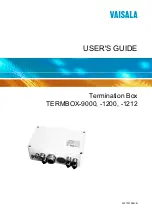
Appendix C: Glossary
10BaseT
- An Ethernet standard that uses twisted wire pairs.
100BaseTX
- IEEE physical layer specification for 100 Mbps over two pairs of
Category 5 UTP or STP wire.
Adapter
- Printed circuit board that plugs into a PC to add to capabilities or
connectivity to a PC. In a networked environment, a network interface card
(NIC) is the typical adapter that allows the PC or server to connect to the
intranet and/or Internet.
Backbone
- The part of a network that connects most of the systems and net-
works together and handles the most data.
Bandwidth
- The transmission capacity of a given facility, in terms of how
much data the facility can transmit in a fixed amount of time; expressed in bits
per second (bps).
Bit
- A binary digit. The value - 0 or 1-used in the binary numbering system.
Also, the smallest form of data.
Bridge
- A device that interconnects different networks together.
CAT 5
- ANSI/EIA (American National Standards Institute/Electronic
Industries Association) Standard 568 is one of several standards that specify
"categories" (the singular is commonly referred to as "CAT") of twisted pair
cabling systems (wires, junctions, and connectors) in terms of the data rates
that they can sustain. CAT 5 cable has a maximum throughput of 100 Mbps and
is usually utilized for 100BaseTX networks.
CPU
(
C
entral
P
rocessing
U
nit) - The computing part of the computer. Also
called the "processor," it is made up of the control unit and ALU.
Database
- A database is a collection of data that is organized so that its con-
tents can easily be accessed, managed, and updated.
Data Packet
- One frame in a packet-switched message. Most data communi-
cations is based on dividing the transmitted message into packets. For example,
an Ethernet packet can be from 64 to 1518 bytes in length.
13
12
EtherFast
®
16-Port and 24-Port 10/100 Ethernet Switches
Instant EtherFast
®
Series
An Ethernet Switch’s
autosensing
feature gives you a key advantage over other
forms of networking by upgrading speed-critical network segments to
100Mbps while allowing existing 10BaseT subnetworks to operate within it.
Running 10BaseT and 100BaseTX hardware speeds alongside each other in an
Ethernet Switch eliminates the need to purchase new hardware, rewire, and
reconfigure an entire site all at once. This
scalability
factor ensures that Fast
Ethernet will not fall obsolete to upgrades in speed standards and maintains use
of all your old equipment until you decide to buy speedier replacements.
Otherwise, throwing away all your older, slower equipment in an old-fashioned
“forklift upgrade” is the only other alternative.
Scalability allows you to budget for your networking needs over time.
Now networks can custom-run fast and slow segments at the same time for dif-
ferent users or departments. Publishing, R&D, video, and accounting depart-
ments can enjoy a blazing 100Mbps transfer, while other corporate segments
conserve bandwidth by operating at more economical 10Mbps speeds.
Switches also feature
full duplex data transfer
, meaning that all computers on
the switch can “talk” to the switch at the same time. Plus, switches are able to
send and receive data simultaneously to all connections, whereas a hub cannot.
A hub simply works with one computer at a time, and only sends or receives
data, since it cannot handle two way communication.
In addition to full duplex transfer, an Ethernet Switch surges your network with
dedicated bandwidth
to each node, devoting 100Mbps to every device and
multiplying your bandwidth for each added node. For instance, if you connect
five computers, capable of running at 100 Mbps, to an Ethernet Switch, then
each computer will get a dedicated bandwidth of 200Mbps in full duplex trans-
fer mode. If you run the same computers from a 100Mbps hub, then each com-
puter would only share a part of the bandwidth, depending on how many other
computers are running on the network, and how data-intensive the workload.
A network without a switch is called a
shared network
because every node on
the network competes for a fraction of the total bandwidth. In a shared network,
data packets are randomly broadcasted to all stations until they discover their
intended destination. Consequently, considerable time and bandwidth is wast-
ed on data packets traveling along network lines before they find their correct
address. A switch, on the other hand, features a
store-and-forward function
which retains the address for each data packet and shoots them straight to the
correct destination.
































